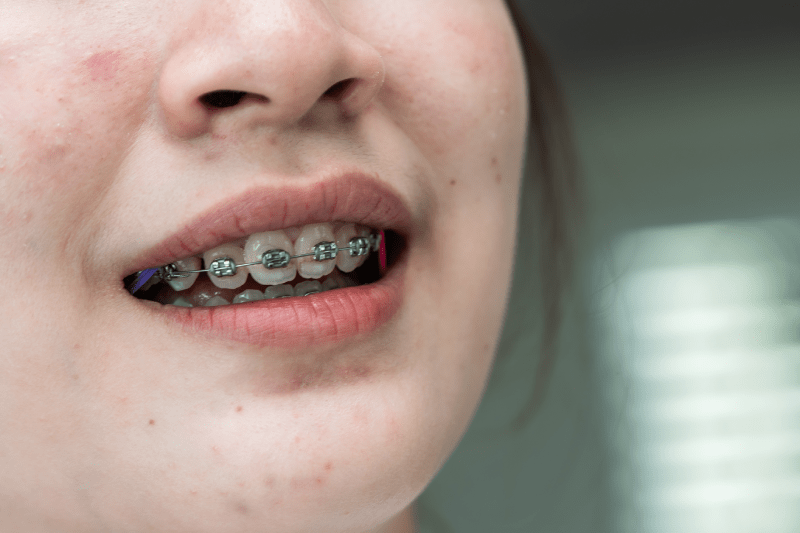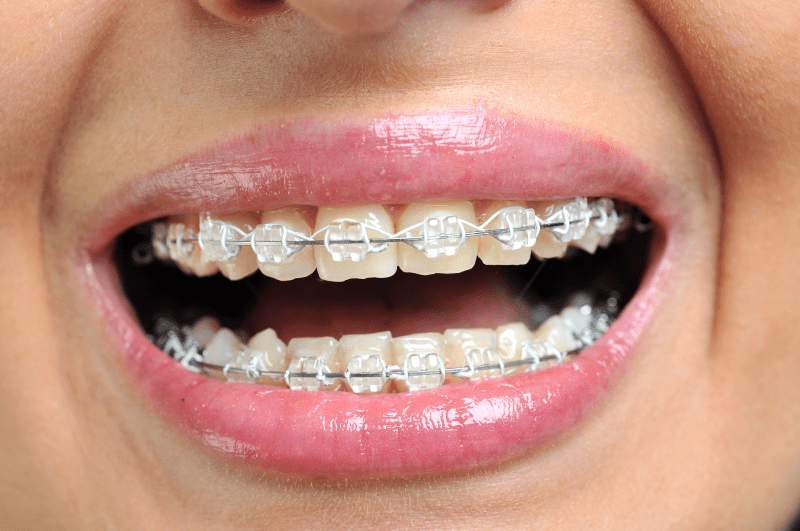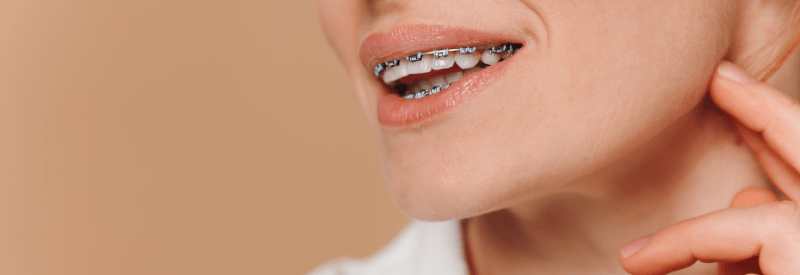What Is Braces Treatment And Why Is It Done?
Braces treatment, or orthodontic treatment, is a process applied to correct irregularities in the position of the teeth and jaws, aiming to achieve both aesthetic and functional alignment. This treatment is necessary to resolve problems such as crowded teeth, gaps between teeth, malocclusions (bad bites), and upper and lower jaw discrepancies. The primary goal of the treatment is to bring the teeth into their ideal positions, improving chewing function, correcting speech disorders, and creating a healthier, more aesthetic smile. Straightened teeth are also easier to clean, which reduces the risk of gum diseases and cavities, making it a critical investment for long-term oral health.
What Is The Cost Of Braces Treatment In Turkey?
The cost of braces treatment in Turkey varies across a wide range depending on the complexity of the case to be treated, the type of appliance to be used (metal, ceramic, lingual, clear aligners), and the estimated duration of the treatment. Generally, orthodontic treatment prices in Turkey are much more economical compared to equivalent treatments in Western European and North American countries, creating a significant savings advantage for international patients. Costs are usually presented as a package price intended to cover the entire treatment period, adjustments, and initial registration fees. A first consultation and detailed dental analysis are essential to obtain a definitive price.
How Are Orthodontic Treatment Prices Determined In Istanbul?
In Istanbul, factors such as the clinic’s location, the orthodontist’s level of experience, and the technological infrastructure used play a significant role in determining the price of orthodontic treatment. Clinics located in central and luxurious districts of the city may charge slightly higher prices due to increased operating costs. Prices are also shaped by fundamental details, such as whether the treatment covers a single jaw or both jaws. Some clinics may request the full fee upfront at the start of the treatment, while others offer payment in monthly installments, adjusting the payment plan to the patient’s convenience. Therefore, it is necessary to examine price quotes in detail.
What Are The Main Factors Affecting The Braces Treatment Cost?
The most critical factor influencing the cost of braces treatment is the severity of the malocclusion (bad bite). Mild crowding takes less time and is less costly, whereas complex cases requiring skeletal problems or jaw surgery, or those needing tooth extraction, are more expensive. The second major factor is the type of bracket or appliance used. While traditional metal brackets are the most affordable option, ceramic brackets, lingual braces, and especially clear aligner systems significantly increase the cost. Finally, the experience of the specialist carrying out the treatment and the total duration of the treatment also directly impact the price you will pay.
What Are The Price Differences Among Different Types Of Braces?
The price difference among various types of braces depends on the cost of the material used, the difficulty of application, and technological requirements. Traditional metal braces are the most economical option. Ceramic (clear) braces, often preferred due to aesthetic concerns, can be approximately 20% to 40% more expensive than metal braces. The most expensive options are generally Lingual Orthodontics (braces applied to the back surface of the teeth) and Clear Aligner Treatment, as these methods require custom fabrication and advanced digital planning. These differences necessitate the patient finding a balance between their aesthetic expectations and their budget for the treatment.
What Is The Cost Of Traditional Metal Braces?
Traditional metal dental braces are the most common and budget-friendly option for orthodontic treatment. The cost of treatments performed with these braces in Turkey is markedly lower compared to other orthodontic appliances. Metal braces are extremely effective even in complex cases due to their robustness and ability to move teeth quickly and reliably. The cost advantage stems from the fact that the manufacturing and application process of metal brackets is more standard and easier than aesthetic alternatives. A lower cost does not imply a compromise on quality; it simply means the material cost and technological complexity are lower for this specific system.
How Much More Expensive Are Clear (Ceramic) Braces Than Metal?
Clear or ceramic dental braces are frequently preferred by adult patients who have concerns about the aesthetic appearance of the treatment. Due to the manufacturing costs of the ceramic material and its fragility, which requires more careful application, these braces are priced higher than traditional metal braces. Patients can generally expect an additional cost of 20% to 50% compared to the cost of metal braces. However, this extra charge is counterbalanced by the aesthetic advantage of the braces being the same color as the teeth, making the treatment much less noticeable. The price difference may also vary based on the clinic’s supplier and the specific quality of the ceramic used.
What Is The Application And Cost Of Lingual (Behind The Tooth) Braces?
Lingual orthodontics is an extremely aesthetic treatment method where the braces are placed on the inner (tongue) side of the teeth, making them completely invisible from the outside. The application process requires personalized 3D scanning of the inner tooth surfaces and the precise laboratory production of custom-made brackets based on these scans. This high degree of personalization and the difficulty of the application technique make lingual braces the most expensive option among orthodontic choices. Their cost can be double or even more than that of traditional treatment. The special training and experience of the clinician applying this specific method are also critical factors in determining the price.
What Is The Price Difference For Invisible Orthodontics (Clear Aligners)?
Invisible orthodontics, or clear aligners, has gained significant popularity, especially for treating mild to moderate crowding. This treatment is carried out using a series of transparent, removable aligner trays. Since the aligners must be digitally designed and custom-manufactured for each patient, the cost is typically 50% to 100% higher than that of metal braces. However, because they offer patients freedom in eating and drinking and greater aesthetic comfort, many people find this price difference acceptable. The number of aligner trays required and the complexity of the case are the most crucial elements that directly influence the total price of the treatment.

How Does Treatment Duration Affect The Cost?
The cost of orthodontic treatment is directly proportional to the treatment duration because as the total time increases, so does the clinician’s time commitment, the quantity of auxiliary materials used (wires, elastics), and the number of monthly check-up appointments. A typical case lasts an average of 18 to 24 months. If the treatment extends to 36 months or longer, clinics generally charge a higher fee that reflects this extended period. Advanced techniques used to shorten the treatment time (such as accelerated devices) may also increase the initial cost. For successful cost planning, you should receive a clear estimate of the treatment duration from your specialist.
Is Clinic And Clinician Experience Important In Pricing?
Yes, the experience of the clinic and especially the orthodontic specialist performing the treatment is a significant factor in pricing. Clinicians who have successfully completed thousands of cases over the years, hold international certifications, and specialize in specific areas (such as Lingual or clear aligners) can naturally command higher fees. This price difference is often viewed as a guarantee for receiving faster, more accurate treatment with fewer complications. Clinics also reflect their investments in state-of-the-art equipment and high hygiene standards in their prices. Therefore, carefully evaluating the price-to-quality balance is critically important for your investment.
What Are The Quality Standards Of Braces Treatment In Turkey?
Modern orthodontic clinics in Turkey, particularly those serving the health tourism sector, adhere to high international quality standards. These clinics typically follow the protocols set by European and American Orthodontic Associations. All brackets, wires, and aligners used are sourced from global brands with FDA approval. Treatments are performed by orthodontists who have received specialist training in dentistry faculties. Furthermore, the widespread use of advanced technologies such as digital measurement (3D scanning) and treatment planning elevates the quality and precision of the care provided to the highest level, ensuring optimal results.
Is The Initial Examination And Consultation Fee-Based?
Whether the initial examination and consultation before starting orthodontic treatment are subject to a fee varies from clinic to clinic. Some large health tourism clinics may offer this initial assessment free of charge to attract patients, and remote pre-consultations may be free, especially if the patient sends their dental X-rays and photos. However, comprehensive diagnostic stages, such as detailed analyses, taking impressions, and panoramic and cephalometric X-rays, are always charged separately. If the patient decides to proceed with the treatment, the initial consultation fee may often be deducted from the total treatment cost, serving as an incentive.
Are Control Appointments Included In The Prices?
In the vast majority of comprehensive package price quotes offered for orthodontic treatment, routine control and adjustment appointments conducted at monthly or six-week intervals are included in the cost. These appointments are an integral part of the treatment and involve force adjustments to the braces, changing elastics, or replacing brackets. However, exceptions may occur where an additional fee might be charged, such as if the patient misses appointments frequently or if the treatment duration extends far beyond the estimated time. Therefore, it is essential to clarify precisely how many control appointments are included when receiving the price quotation.
Are There Extra Costs During The Treatment?
Generally, clinics strive to provide a clear package price quote that covers the entire duration of the treatment and all routine adjustments. However, certain situations that may arise during treatment can lead to extra charges. These may include necessary procedures not included in the package, such as tooth extractions, gum treatments, or fillings required before starting the treatment. An additional repair fee may be requested if a bracket breaks or is lost during the treatment. Furthermore, retention appliances used after the treatment is completed may be listed as a separate cost item in some packages. It is important to inquire about these potential extra costs in advance.
How Does The Comparison Of Overseas Prices With Turkey Prices Look?
Orthodontic treatment prices in Turkey are generally 50% to 70% lower when compared to Western countries. For example, clear aligner treatment, which is high-cost in countries like the USA, Canada, or the UK, is offered at a much more accessible price in Turkey. This significant price difference is primarily due to Turkey’s lower operating, labor, and general cost of living expenses. Despite the price difference, the quality of the materials used and the expertise of the specialist clinicians meet international standards. This affordability is the main reason why many international patients choose Turkey for their braces treatment.
What Does The Turkish Lira Exchange Rate Advantage Mean For Foreign Patients?
The value of the Turkish Lira against other major currencies (Euro, Dollar, Sterling) creates a considerable exchange rate advantage for foreign patients. Patients paying in foreign currency can receive the same high-quality service for a much smaller fraction of the amount they would pay in their home countries. This financial advantage is evident not only in the treatment cost but also in other expenses such as accommodation, food, and travel in Istanbul. The exchange rate advantage makes Turkey a very attractive health tourism destination, especially for long-term treatments like orthodontics, which span 18 to 24 months.
What Preparations Are Required Before Starting Treatment?
Before starting braces treatment, oral and dental health must be in an optimal state. The orthodontist will request detailed dental X-rays (panoramic and cephalometric), tooth impressions or 3D scans, and facial photographs, collectively known as records, from the patient. These records form the basis of the treatment plan. Additionally, treating any existing dental decay, completely curing gum diseases, and performing all necessary tooth extractions (if any) are mandatory prerequisites. Eliminating all sources of infection in the mouth before the braces are placed is vital for the successful and uninterrupted progression of the treatment.

What Is The Average Duration Of Treatment?
The duration of orthodontic treatment varies significantly depending on the type and severity of the dental and jaw misalignment. On average, simple cases can be completed between 6 and 12 months, while most moderate to complex cases take between 18 and 30 months. Treatments involving the correction of skeletal discrepancies or those combined with jaw surgery may extend up to 36 months. The patient’s diligence in wearing elastics, not missing control appointments, and adhering to the clinician’s instructions are the most crucial factors influencing the estimated treatment duration.
Is Pain Or Discomfort Felt During Braces Treatment?
Persistent pain is not experienced during braces treatment, but it is normal to feel temporary discomfort, sensitivity, or mild pressure during the first few days after the braces are first placed and after every adjustment (activation) appointment. This discomfort results from the teeth beginning to move and usually subsides and disappears within a few days. Orthodontic wax can be used to prevent irritation caused by the wires on the lips or cheeks. Simple painkillers are sufficient to manage severe pain. Patients quickly become accustomed to the presence of the braces and can comfortably continue their daily lives.
Can Adults Get Braces Treatment?
Yes, there is no age limit for braces treatment, and adults can successfully undergo orthodontic treatment. Teeth can be moved at any age, provided the bone health is adequate. In fact, a significant portion of patients receiving orthodontic treatment today are adults. The treatment duration in adults may sometimes be slightly longer than in adolescents due to the denser bone structure. Adults typically prefer ceramic or lingual braces and clear aligners due to aesthetic concerns. The treatment process yields results as effective and successful as in younger patients.
When Should Orthodontic Treatment Start In Children?
The timing for starting orthodontic treatment in children varies depending on the type of case. Orthodontists generally recommend the first orthodontic examination around age 7. Early treatment (Phase I) is important at this age to guide jaw growth problems or severe bite issues and is typically done between ages 7-10. However, comprehensive treatment aimed at straightening all teeth (Phase II) usually begins after all permanent teeth have erupted, which is around 12-14 years of age. Early diagnosis can help prevent more invasive treatments, such as jaw surgery, in later years.
How Should One Eat During The Treatment Period?
Paying attention to diet during braces treatment is critically important to prevent bracket breakages and maintain dental health. Hard foods (hard fruits, nuts, ice) and sticky foods (caramel, gum, Turkish delight) should be strictly avoided, as they can dislodge brackets or bend wires. Hard foods must be cut into small pieces or shredded before consumption. Furthermore, the consumption of acidic and sugary drinks should be limited because these can increase the risk of cavities when brushing around the wires becomes more difficult. Soft, pureed foods and soups are ideal for the first few days after adjustments.
How Should Oral Hygiene Be Maintained With Braces?
Maintaining oral hygiene with braces requires more attention and time than normal brushing, but it is vital for preventing decay and gum disease. Patients must use special orthodontic toothbrushes, interdental brushes, and floss (superfloss) that can be threaded under the wires. All surfaces of the teeth and braces must be meticulously brushed after every meal. Additionally, using a fluoride mouthwash, as recommended by the dentist, can also be beneficial. Consistently adhering to the hygiene routine is the most crucial rule for a successful treatment and for having healthy teeth at the end of the process.
Is The Retention (Retainer) Phase Compulsory After Treatment?
Yes, one of the most important and mandatory stages of braces treatment is the retention phase. After teeth have been moved from their positions, they have a tendency to revert to their old locations (relapse). Retainer appliances ensure the teeth are stabilized in their new positions, preventing this reversion and ensuring the treatment result is permanent for life. Retainers are typically used both as fixed (thin wires glued to the back of the teeth) and removable appliances (clear aligners or Hawley retainers). This stage must be diligently followed for the duration specified by the orthodontist to protect the success of the treatment.
Is The Retention Phase Included In The Cost?
The cost of the Retention (Retainer) phase can vary depending on the initial treatment package purchased. Some comprehensive treatment packages may include one set of fixed (bonded) and one set of removable retainers to be used after the completion of the treatment. However, in some economic packages, these appliances may be offered as an extra cost item. If removable retainer trays are lost or broken over time, an additional fee will always be required to fabricate a replacement. Therefore, it is crucial to clearly ask if the “retainer” cost is included when receiving the initial price quote.
What Are The Cosmetic Benefits Of Braces Treatment?
The cosmetic benefits of braces treatment are extensive and go far beyond just straight teeth alignment. The treatment ensures that the teeth are perfectly aligned, creating a more balanced and aesthetic smile line. It can also correct aesthetic imbalances in facial symmetry or lip-to-jaw proportions that may have resulted from improper bites. Straight teeth look brighter and healthier, which significantly boosts the patient’s self-confidence and comfort in social life. The final result of the treatment is not only a healthy mouth but also a visibly more attractive appearance that enhances the patient’s overall well-being.
What Should Be Considered Before Starting The Treatment?
The most critical point to consider before starting orthodontic treatment is the selection of the orthodontist and the clinic’s technological capability. It must be ensured that the clinician performing the treatment is indeed an orthodontist certified by the Turkish Ministry of Health. The clinic’s hygiene standards and the quality of the bracket/aligner brands used should be verified. Furthermore, it is necessary to ensure that the treatment duration is realistically planned and to obtain all cost items (including potential extra fees) in writing. Openly sharing all expectations and concerns with the clinician before starting the treatment is paramount for the process’s success.
Is It Logical To Go To Istanbul For Braces Treatment?
Choosing Istanbul for braces treatment is highly logical due to the combination of high-quality service, experienced specialists, and economic cost. The significant exchange rate advantage offered, especially for patients coming from Western countries, substantially reduces the total treatment cost. Istanbul provides modern clinics and the use of advanced technology, enabling the optimization of the treatment duration. Furthermore, the opportunity to spend time between appointments exploring one of the world’s most beautiful and historic cities makes this option exceptionally appealing. This situation maximizes the health tourism experience in terms of both cost and benefit.

How Should Accommodation And Transportation Processes Be Planned?
Since orthodontic treatment is a long-term process (1-3 years), patients may only need to stay in Istanbul for the first and final stages, but they must also plan short trips for routine monthly check-ups. For the initial session, comfortable accommodation close to the clinic should be preferred. Thanks to Istanbul’s developed public transport network (metro, tram), it is possible to stay in central areas and easily reach the clinics. Intermediary agencies like Cure Holiday handle all travel and accommodation arrangements (airport transfers, hotel reservations), providing the logistical support necessary for patients to focus solely on their treatment and minimizing planning stress.
What Is The Origin Of The Materials Used In Braces Treatment?
Reliable orthodontic clinics in Turkey source all materials used in braces treatment (brackets, wires, elastics, clear aligners) from globally recognized manufacturers with FDA/CE approval (such as brands like 3M, Ormco, and Align Technology). This practice guarantees that the quality and biocompatibility of the materials are of the highest standard. Low-quality or unsafe materials produced locally are rarely, if ever, used in these clinics. Asking your clinician about which brand of bracket or aligner system will be used before starting your treatment will provide peace of mind regarding quality assurance.
Is A Guarantee Provided If The Treatment Fails?
Since the success of orthodontic treatment largely depends on patient cooperation (taking good care of the braces, wearing aligners regularly), clinics generally do not offer a full “money-back” guarantee regarding the outcome. However, a clinic-internal warranty may be offered against any failure arising from technical errors in the treatment process or bracket breakages under normal use. Most importantly, in the event of retention phase failure (teeth shifting back), clinicians often offer corrective treatment for a limited period without charging an additional fee. The terms of the guarantee should be clearly stated in writing at the beginning of the treatment agreement.
How Is Follow-Up Managed From Abroad During Treatment?
In the long-term braces treatment process, it may not be practical for international patients to travel to Istanbul every month. Therefore, many clinics and Cure Holiday utilize digital communication methods to facilitate treatment follow-up. The patient takes and sends photographs of their teeth and braces to the specialist at specified intervals. Video consultations are arranged when necessary. This approach allows for collaboration with a local dentist for routine and minor adjustments, or critical appointments requiring travel to Istanbul are predetermined. This digital follow-up ensures the treatment process progresses smoothly and according to plan.
Does Insurance Cover The Cost Of Braces Treatment?
Whether private health insurance covers the cost of braces treatment largely depends on the type and scope of the policy. Many international insurances only cover orthodontic treatment when it is a medical necessity (e.g., skeletal disorders requiring jaw surgery) or for children under 18 years of age. Treatments for purely aesthetic purposes in adults are generally excluded from coverage. Before receiving treatment in Turkey, it is mandatory to confirm with your insurance company the specific orthodontic coverage of your policy and the reimbursement procedures for treatments performed in Turkey. Cure Holiday can assist you in preparing your insurance documentation for this process.
What Kind Of Support Does Cure Holiday Provide In This Process?
Cure Holiday offers you comprehensive and reliable support from start to finish throughout your orthodontic treatment journey in Turkey. They connect you with accredited orthodontic specialists, securing the most suitable price quotes and personalized treatment plans for you. They manage medical coordination services, such as delivering your necessary dental X-rays and records to the specialist and organizing your initial consultation. Furthermore, they undertake all the logistical planning required for your accommodation, airport transfers, and continuous communication throughout the treatment, thereby eliminating stress from the entire process. Throughout your treatment, Cure Holiday serves as your seamless point of contact.
